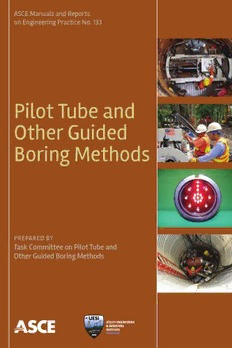
Pilot tube and other guided boring methods PDF
Preview Pilot tube and other guided boring methods
ASCE Manuals and Reports on Engineering Practice No. 133 Pilot Tube and Other Guided Boring Methods PREPARED BY Task Committee on Pilot Tube and Other Guided Boring Methods ASCE Manuals and Reports on Engineering Practice No. 133 Pilot Tube and Other Guided Boring Methods Prepared by Task Committee on Pilot Tube and Other Guided Boring Methods of the Committee on Trenchless Installations of Pipelines of the Utility Engineering and Surveying Institute of the American Society of Civil Engineers Published by the American Society of Civil Engineers LibraryofCongressCataloging-in-PublicationData Names: Utility Engineering and Surveying Institute (American Society of Civil Engineers). TaskCommitteeonPilotTubeandOtherGuidedBoringMethods,author. Title:Pilottubeandotherguidedboringmethods/preparedbyTaskCommitteeonPilotTube andOtherGuidedBoringMethodsoftheCommitteeonTrenchlessInstallationsofPipelinesof theUtilityEngineeringandSurveyingInstituteoftheAmericanSocietyofCivilEngineers. Description:Reston,Virginia:AmericanSocietyofCivilEngineers,[2017]| Series:ASCEmanualsandreportsonengineeringpractice;no.133| Includesbibliographicalreferencesandindex. Identifiers:LCCN2017010889|ISBN9780784414743(paperback:alk.paper)| ISBN9780784480571(PDF)|ISBN9780784480663(ePUB)| Subjects:LCSH:Undergroundpipelines–Equipmentandsupplies.|Tubes.|Underground pipelines–Designandconstruction.|Directionaldrilling–Equipmentandsupplies.| Trenchlessconstruction.|Boring. Classification:LCCTJ933.P482017|DDC621.8/672–dc23LCrecordavailableathttps:// lccn.loc.gov/2017010889 PublishedbyAmericanSocietyofCivilEngineers 1801AlexanderBellDrive Reston,Virginia,20191-4382 www.asce.org/bookstore|ascelibrary.org Anystatementsexpressedinthesematerialsarethoseoftheindividualauthorsanddonot necessarilyrepresenttheviewsofASCE,whichtakesnoresponsibilityforanystatementmade herein. No reference made in this publication to any specific method, product, process, or serviceconstitutesorimpliesanendorsement,recommendation,orwarrantythereofbyASCE. ThematerialsareforgeneralinformationonlyanddonotrepresentastandardofASCE,nor aretheyintendedasareferenceinpurchasespecifications,contracts,regulations,statutes,or anyotherlegaldocument.ASCEmakesnorepresentationorwarrantyofanykind,whether express or implied, concerning the accuracy, completeness, suitability, or utility of any information, apparatus, product, or process discussed in this publication, and assumes no liabilitytherefor.Theinformationcontainedinthesematerialsshouldnotbeusedwithoutfirst securingcompetentadvicewithrespecttoitssuitabilityforanygeneralorspecificapplication. Anyoneutilizingsuchinformationassumesallliabilityarisingfromsuchuse,includingbut notlimitedtoinfringementofanypatentorpatents. ASCE andAmericanSociety of CivilEngineers—Registeredin U.S. Patentand Trademark Office. Photocopies and permissions. Permission to photocopy or reproduce material from ASCE publicationscanberequestedbysendingane-mailtopermissions@asce.orgorbylocating atitleinASCE’sCivilEngineeringDatabase(http://cedb.asce.org)orASCELibrary(http:// ascelibrary.org)andusingthe“Permissions”link. Errata:Errata,ifany,canbefoundathttp://dx.doi.org/10.1061/9780784414743 Copyright©2017bytheAmericanSocietyofCivilEngineers. AllRightsReserved. ISBN978-0-7844-1474-3(paper) ISBN978-0-7844-8057-1(PDF) ISBN978-0-7844-8066-3(ePUB) ManufacturedintheUnitedStatesofAmerica. 21 20 19 18 17 1 2 3 4 5 MANUALS AND REPORTS ON ENGINEERING PRACTICE (As developed by the ASCE Technical Procedures Committee, July 1930, and revised March 1935, February 1962, and April 1982) A manual or report in this series consists of an orderly presentation of facts on a particular subject, supplemented by an analysis of limitations andapplicationsofthesefacts.Itcontainsinformationusefultotheaverage engineer in his or her everyday work, rather than findings that may be useful only occasionally or rarely. It is not in any sense a “standard,” however; nor is it so elementary or so conclusive as to provide a “rule of thumb” for nonengineers. Furthermore, material in this series, in distinction from a paper (which expresses only one person’s observations or opinions), is the work of a committee or group selected to assemble and express information on a specifictopic.Asoftenaspracticablethecommitteeisunderthedirection of one or more of the Technical Divisions and Councils, and the product evolved has been subjected to review by the Executive Committee of the Division or Council. As a step in the process of this review, proposed manuscripts are often brought before the members of the Technical Divisions and Councils for comment, which may serve as the basis for improvement. When published, each work shows the names of the committees by which it was compiled and indicates clearly the several processes through which it has passed in review, so that its merit may be definitely understood. In February 1962 (and revised in April 1982), the Board of Direction voted to establish a series titled “Manuals and Reports on Engineering Practice,”toincludetheManualspublishedandauthorizedtodate,future ManualsofProfessionalPractice,andReportsonEngineeringPractice.All suchManualorReportmaterialoftheSocietywouldhavebeenrefereedin amannerapprovedbytheBoardCommitteeonPublicationsandwouldbe bound, with applicable discussion, in books similar to past Manuals. Numberingwouldbeconsecutiveandwouldbeacontinuationofpresent Manual numbers. In some cases of joint committee reports, bypassing of Journal publications may be authorized. A list of available Manuals of Practice can be found at http://www.asce.org/ bookstore. This page intentionally left blank CONTENTS PREFACE...........................................................................................................ix ACKNOWLEDGMENTS................................................................................xi ABBREVIATIONS AND ACRONYMS....................................................xiii 1. INTRODUCTION......................................................................................1 References ........................................................................................5 2. THE PILOT TUBEAND OTHER GUIDED BORING METHODSINDETAIL...........................................................................7 2.1 Introductionto the Pilot Tube Method.........................................7 2.2 Inserting the Pilot Tube...................................................................9 2.3 Enlarging the Pilot Tube Path......................................................15 2.4 PilotTube as a Guide for Other Trenchless Methods..............24 2.5 Variations and Refinements to the Pilot Tube Method and Other GuidedBoring Methods....................................................30 2.6 Applications....................................................................................37 2.7 Benefits and Limitations................................................................42 References ......................................................................................43 3. PLANNING...............................................................................................45 3.1 InitialCriteria..................................................................................45 3.2 Site Conditions................................................................................52 3.3 Preliminary Geotechnical Considerations..................................59 3.4 Project Layout.................................................................................60 3.5 CostConsiderations.......................................................................63 References ......................................................................................72 v vi CONTENTS 4. SITE INVESTIGATION.........................................................................73 4.1 General.............................................................................................73 4.2 Geotechnical Assessment..............................................................73 4.3 UtilitySurveys................................................................................85 4.4 Traffic Flow and Accessfor Vehicles and Pedestrians.............87 4.5 Environmental Conditions............................................................88 4.6 FloodZones.....................................................................................90 4.7 Seismic Considerations..................................................................91 References ......................................................................................93 5. SHAFT DESIGN......................................................................................95 5.1 Jacking and Receiving Shafts........................................................95 5.2 Location...........................................................................................96 5.3 ShaftDesign Considerations........................................................97 5.4 Trenchless Entry/Exitfrom Shafts..............................................98 5.5 Thrust Blocks..................................................................................98 5.6 Common Shafts..............................................................................99 6. PIPE CHARACTERISTICS AND DESIGN......................................101 6.1 GeneralRequirements.................................................................101 6.2 Material Types..............................................................................101 6.3 PipeDesign...................................................................................107 References ....................................................................................115 7. DESIGN AND CONTRACTDOCUMENTS...................................117 7.1 General...........................................................................................117 7.2 Design Memoranda/TechnicalMemoranda............................118 7.3 Calculations...................................................................................118 7.4 Design Considerations.................................................................118 7.5 Contract Documents....................................................................125 7.6 Dispute Resolution.......................................................................130 7.7 Contractor Qualifications............................................................131 References ....................................................................................133 8. CONSTRUCTION.................................................................................135 8.1 General...........................................................................................135 8.2 Bidding...........................................................................................135 8.3 Submittals......................................................................................136 8.4 Measurementand Payment........................................................139 8.5 Jobsite Layout and Equipment Setup.......................................142 8.6 Survey............................................................................................143 8.7 Jacking and Receiving Shafts......................................................147 8.8 SafetyIssues..................................................................................148 8.9 Differing Site Conditions.............................................................149 8.10 Traffic Control, Fencing, and Barricading................................150 CONTENTS vii 8.11 QualityControl.............................................................................150 8.12 Jacking Forces and Lubricants...................................................151 8.13 Spoils Transport and Disposal...................................................152 8.14 Inspection and Monitoring.........................................................153 8.15 Reports and Records....................................................................154 8.16 As-Built Drawings and Documentation...................................154 References ....................................................................................155 GLOSSARY....................................................................................................157 INDEX.............................................................................................................169 This page intentionally left blank PREFACE This manual of practice was prepared by the Task Committee on Pilot Tube and Other Guided Boring Methods of the ASCE Committee on TrenchlessInstallationofPipelines(TIPS),aspartoftheUtilityEngineering &Surveying Institute (UESI).The manualdescribesthe current pilottube and other guided boring methods used by engineers and construction professionals in designing and installing pipelines to a design line and grade under roads, railroads, streets, and other constructed and natural structures and obstacles. This manual of practice has been created by a group of engineers, owners, suppliers, manufacturers, and contractors fully knowledgeable of the method and its use. This manual takes into account many of the advances that have occurred over the years in the guiding of trenchless methods. Many of the sections provide a summary of the state of the industryasof2016.Thetaskcommitteeacknowledgesthatthetechnology continuestochangeandthatchangesinconstructioncontinuetodevelop. Sections have been written assuming the reader may be new to the various construction methods included in this manual. No document including this one can encompass all of the issues on a particular pilot tube or other guided boring project. Improvements in best practices and technologycontinuetoevolvesoquicklythatconsiderationofthismanual onanyprojectmusttakeintoaccountnotonlythespecificcharacteristicsof the particular project but also further improvements in best practices and technology. Theengineerofapipelineprojectisencouragedtoconsideralltrenchless methodsbeforeconcludingthatthepilottubeand/orotherguidedboring methods are the most suitable construction methods available. Manuals andreportsonengineeringpractice(knownasMOPs)havebeenwrittenby ASCE for different construction methods. A list of useful references is provided at the end of Chapter 1. ix
